{{ quickViewProduct.product_title }}
Stock ID
{{ quickViewProduct.product_stock_number }}
Product Features:
- {{ feature.product_feature_description }}
{{ option.product_option_title }}
{{ value.product_option_value_title }}
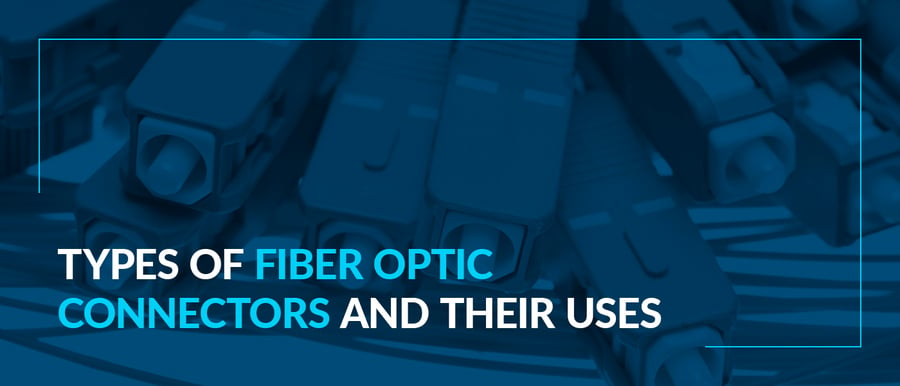
Connectors, also called terminations, link cables together with a secure connection that permits pulses to travel through the cable without interruption. To accommodate different applications, there are many fiber optic connector types. Choosing between the correct connector types for specific use ensures ideal performance of the fiber optics cables and the devices they connect.
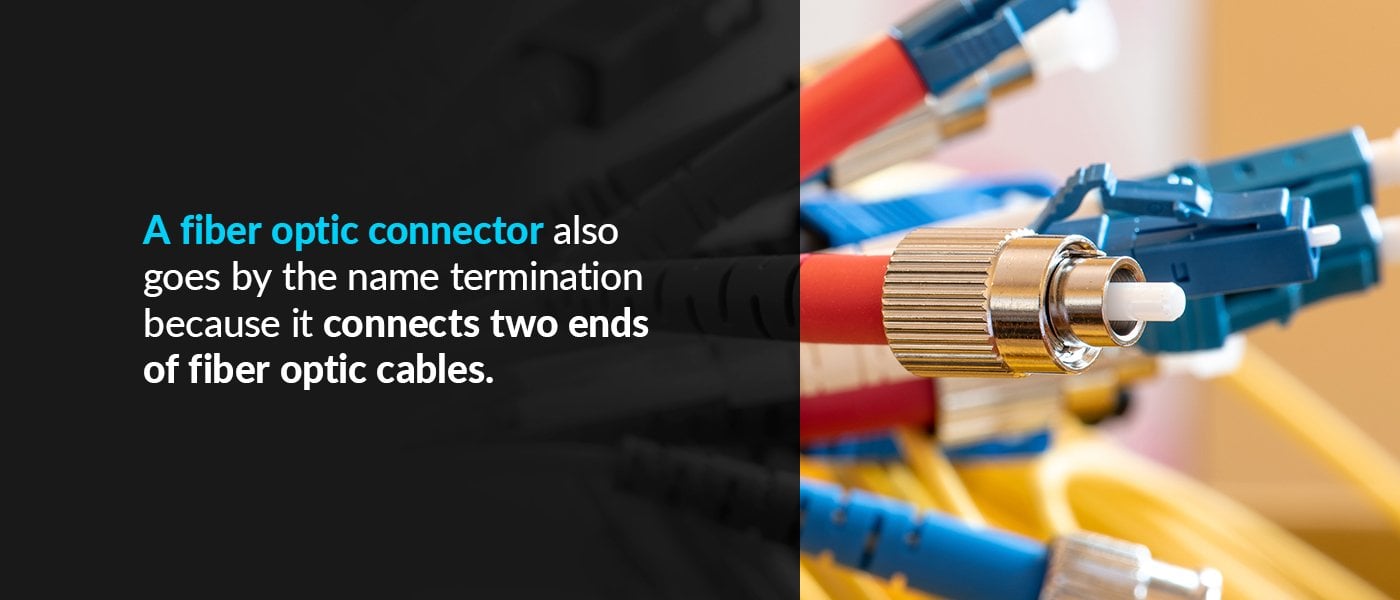
A fiber optic connector also goes by the name termination because it connects two ends of fiber optic cables. These connectors hold the fiber optic cables together inside the ferrule to attach them to the other side of the cables. Ferrules are the connector end pieces that include the method of connecting and securing the termination. Some ferrules will plug into a mating adapter and screw to hold the two portions together. Others use a bayonet design, while some snap together.
Some ferrules have a spring-loaded connector to hold the pieces together with constant force for improved connection. Most fiber optic connectors require effort to connect and disconnect, reducing the chances of accidentally pulling the cables apart during typical use or installation of other components. Connectors can also bring a cable into a converter or directly into the device serviced by the fiber optic cable.
Terminations have multiple uses, depending on the fiber optic cable connector types used. For instance, fiber optics have uses in the following areas:
Fiber optic cables allow for greater bandwidth compared to other cable options. Common uses for networking include fiber optics for delivering internet and LAN connectivity throughout a building. Fiber optic cable works especially well over distances greater than 90 meters and when carrying gigabit-speed connections. Both LAN and high-speed internet use multimode fiber optic cable.
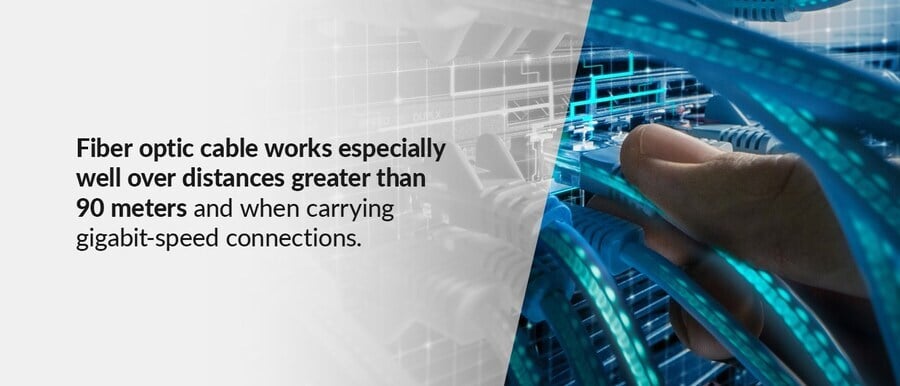
Many companies today have fiber cable going to telecom closets that then transfer the signal to copper-based Cat5 cable and other cables. These cables carry the signal to computers and telephones. However, this practice of using media converters or telecom closets may disappear over time. Innovations in fiber optic technology, high costs for maintaining telecom closets and lowering prices for fiber optics may eventually make all fiber networks the norm.
Community antenna TV and other telecommunications companies often prefer fiber optic cable to deliver their signals due to the lower cost over long distances with less loss and higher bandwidth compared to older technologies. Additionally, each transmitter and receiver pair of fibers can carry more voice and video signals. Compared to wire delivery methods, fiber optics can go 100 times farther and more than 1,000 times faster. CATV may use single-mode fiber optic cabling for its higher bandwidth and lower loss.
Telephony is another system that benefits from fiber optic cable use. Like CATV, many digital telephone applications use single-mode fiber cable. In fact, in the business world, telephony is one of the top uses for fiber optic cables.
Public utilities, such as electrical companies or municipal water treatment facilities, use fiber optics in several ways. They may have fiber optic connected closed-circuit TV (CCTV) security cameras and a network connecting various sites to provide real-time data on operations. Electrical companies, for instance, recognized the interference of their production and distribution equipment on traditional communications wires and made an early switch to fiber optics.
City emergency services also use fiber optics with CCTV, wireless technology and traffic cameras to integrate communications and information sharing among responders. Plus, fiber connectivity through in-city networks can offer higher bandwidth to accommodate large numbers of city workers on the system accessing information at once.
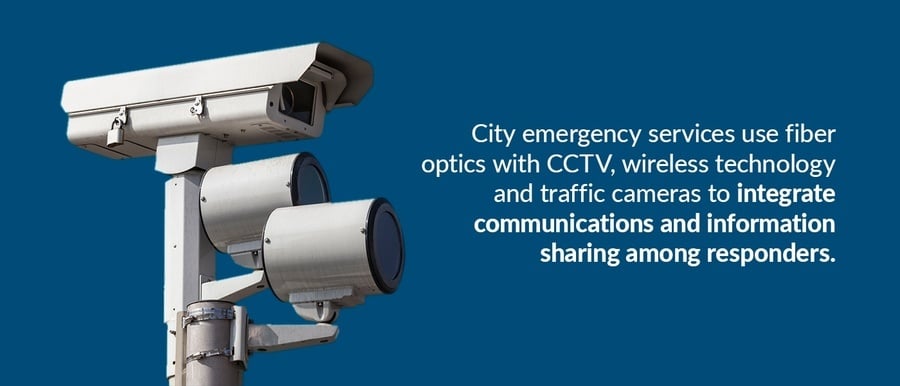
As with electricity companies, electromagnetic interference also plays a role in the choice of communication products used in industrial businesses. Electrical noise from equipment can cause severe problems with unshielded wire cable. But it does not do the same for fiber optics. With many industrial facilities moving into smart operations with devices connected to each other and the internet over a network, reliable connectivity is vital.
For industrial applications, connectors must have firm attachments that cannot easily dislodge, even from constant vibrations caused by machinery operating nearby.
Military operations need connectivity in some of the harshest environments on the planet. Battlefields, naval ships, military bases and planes all need to have means of connecting. Interference, movement and tapping into the communications lines pose threats for the military. Fiber optic cable resolves these issues. Plus, on vehicles and planes, it reduces the weight required for communications hardware.
Security systems often need reliable data transmission lines that can deliver video and audio quickly. Fiber optic cabling for closed-circuit TV (CCTV) offers multiple advantages. First, the two-way direction of fiber optic cable allows an operator to control the camera angle when needed. The ability to control the camera ensures better viewing of suspicious targets, which improves security.
The high bandwidth of fiber optics permits multiple cameras to transfer signals over a single cable. Additionally, fiber optic cable can stretch out over long distances with minimal loss. Therefore, securing cities, airports, warehouses, factories and other larger facilities is possible thanks to fiber-optic connected CCTV. CCTV is not the only security system use for fiber optics, though. Some systems can use sensors and perimeter alarms connected through fiber cable for a comprehensive means of monitoring a property's security.
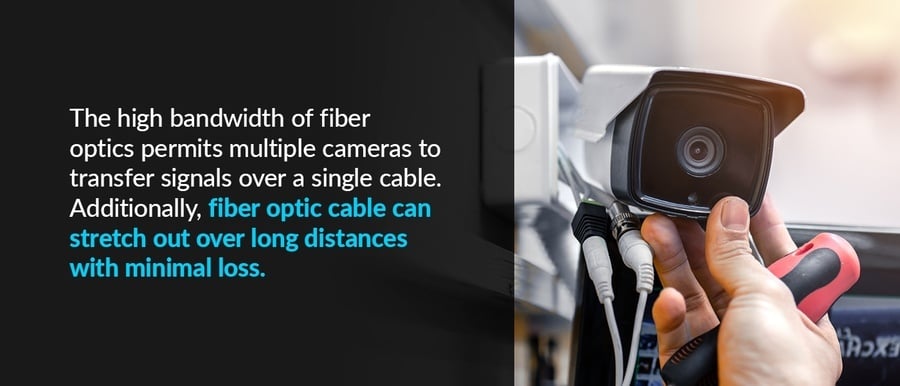
One of the least considered applications of fiber optics is the ability to transfer light over long distances rather than data signals. Therefore, lighting heat-sensitive locations, difficult to reach places or sites where standard electric wiring could be dangerous can use fiber optic lighting. Some common uses of this type of lighting include museum displays near delicate artifacts and in fountains or swimming pools. With multiple filters and the ability to automatically switch them, color-changing effects are possible.
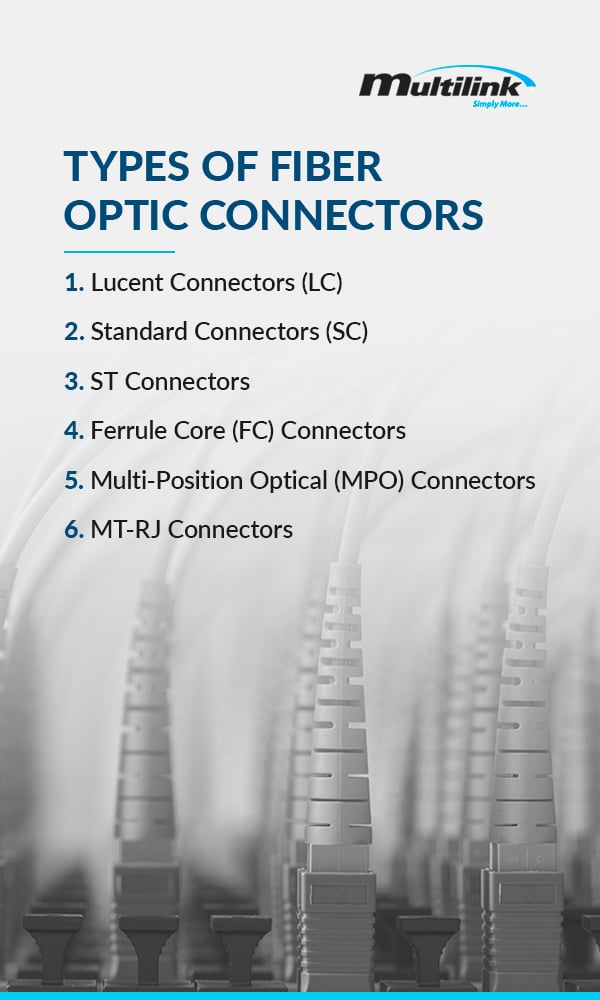
Fiber connectors differ based on what types of cables they connect. For example, single-mode fiber connectors and multimode fiber connectors each pair with the cable with the same mode compatibility.
With many electronics that require fiber optic connections, several types of terminations exist. The most common fiber connectors are LC and SC. SC and LC connector types are so common that many systems have designs to accommodate them. What are the different types of fiber connectors? They are as follows:
LC connectors have some of the smallest ferrules, measuring 1 1/4 mm, which is approximately half the size of an ST connector. Their tiny size puts them into the small form factor category of terminations. These connectors work well for multimode transceivers and single-mode cables.
SC connectors have a 2 1/2 mm ferrule that snaps cleanly into place. Using a push and pull motion secures the connector. These types of terminations have high levels of performance, which along with a price drop since their introduction, has contributed to their vast popularity in multiple applications. In fact, many formerly ST connectors applications now use SC connectors instead, since SC was invented to supplant ST in both telecommunications and data communications.
ST connectors are among the oldest of fiber cable connector types. Until 2005, this proprietary AT&T brand of connector ranked as one of the most popular fiber terminations. While solutions that solve some issues ST connectors present have replaced these connectors, they still remain popular. Today, their cost is low due to their age, making them a choice for budget-mindful projects.
The design of ST connectors is a 2 1/2 mm ferrule that has a bayonet-style connection between the fibers through an adapter. These ferrules use a spring-load design that can make installation difficult unless the parts have precise seating, though a keyed slot assists with aligning the ferrules for connection.
FC connectors rank as some of the most popular for use with single-mode connections before the introduction of LC and SC connectors. These use a keyed, screw-in type ferrule. However, the process of screwing in the ferrule requires extra time and effort compared to snap-in SC connectors.
The screw-in design prevents the connection from interruptions, even when someone pulls the cable or the system has applications in areas with a lot of movement. Video over fiber is one use for these types of connectors due to the constant flow of data through the cable and the security of the connector.
Like ST and SC connectors, FC terminations use a 2 1/2 mm ferrule. With a hybrid adapter, anyone can create a bridge between these connector types.
MTP is the commercial brand of MPO connectors. MTP and MPO connectors are the same, except the MTP brand has a specific use for high-performance applications, whereas MPO works on more mechanical situations. These two connectors usually connect ribbon cables with multiple fibers.
These connectors have two to six rows of 12 or 16 fibers. MPO connectors with 12 fibers per row can have two to six rows, with two the most common number. Connectors that have 16 fibers per row do not have more than two rows. Connections between ferrules use pins and holes to mate the ends of the fiber with another cable or an electronic device. Most often, this type of connector has applications in either high-speed links that use multimode or for pre-terminated cable groupings.
Today, MT-RJ connectors have disappeared from use. However, some systems may still require these connectors for repairs. MT-RJ only works for multimode cables with duplex fibers. Both fibers go into the ferrule that connects to its mated half with pins and holes, similar to MPO terminations. Some plug-and-jack variations on this type of connector also exist.
Fiber connectors have distinctive pros and cons for the different models. When considering the different types of connectors, weigh their applications and the positive and negative attributes of each to ensure proper selection and installation of the terminations.
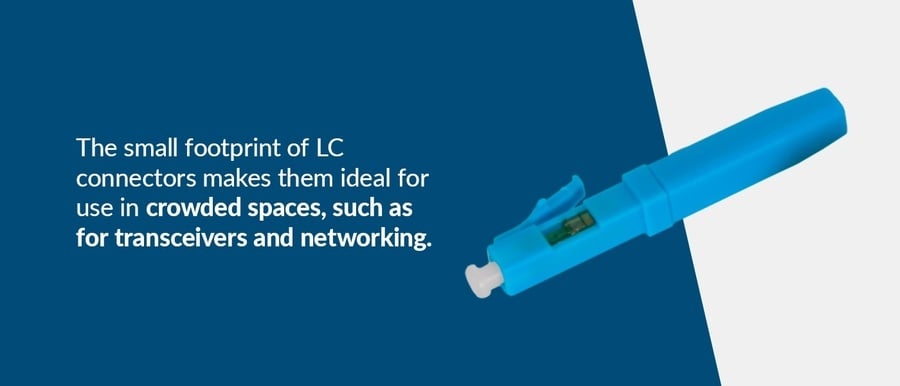
The small footprint of LC connectors makes them ideal for use in crowded spaces, such as for transceivers and networking. Other advantages of these terminations include the ability to use a clip to convert to a duplex from a simplex and the ease of adding a connector to the end of a cable. These connectors also have a design that makes pulling them out of place difficult.
The small size can pose a problem when removing them, especially in high-density sites. Most people have difficulty reaching the clip to disconnect these terminations due to the tiny size of the ferrule and the cramped space these connectors often appear in. Many people solve this issue by using an extractor for LC connectors.
SC connectors have a square shape for the ferrule, which eases arranging them into a small space. Plus, its sturdy hold prevents connection problems, even if someone pulls the cable. This advantage solves an issue with ST connectors that can interrupt fiber optic signals if someone pulls on the cable. Since the SC has a standard 2 1/2 mm size, it can pair with an FC or ST connector with a hybrid adapter.
The disadvantage of using SC connectors is the size of their ferrules. These connectors require more space than small form factor designs, like the LC. Therefore, for the most compact spaces or crowded areas, LC connectors might provide a better solution.
Since ST connectors are older, several multimode fiber cable systems use these types of terminations. While pushing and twisting each spring-loaded ferrule is simple, the process does require more time than other connectors. In some instances, the spring-loaded connector can disrupt the connection by pushing the fibers together when someone pulls the cable.
When working in small spaces, pushing in and twisting each connector also becomes difficult, especially in cases when the two halves do not have proper seating for a solid connection.
FC connectors work in situations that may require assurance of a termination that will interrupt data flow. For applications such as industrial environments or on ships that may encounter rough conditions and cable movement, FC connectors work well.
Since these connectors screw into place, they also need more time for installation. In densely packed spaces, the round shape and screw-in connection require more space for installation and stacking compared to square-shaped SC connectors.
The ability to bundle multiple fibers onto a single connector is the biggest advantage of MPO connectors. When used in high-density situations, MPO connectors can save space compared to SC connectors or other alternatives. Another advantage of some MTP connectors is the ability to remove the exterior housing to easily change the type of connector or repolish the ends.
While MPO connectors offer many advantages over other terminations, especially in crowded racks, this feature also is a drawback. With so many fibers housed in a single connector, cleaning the connectors efficiently is difficult.
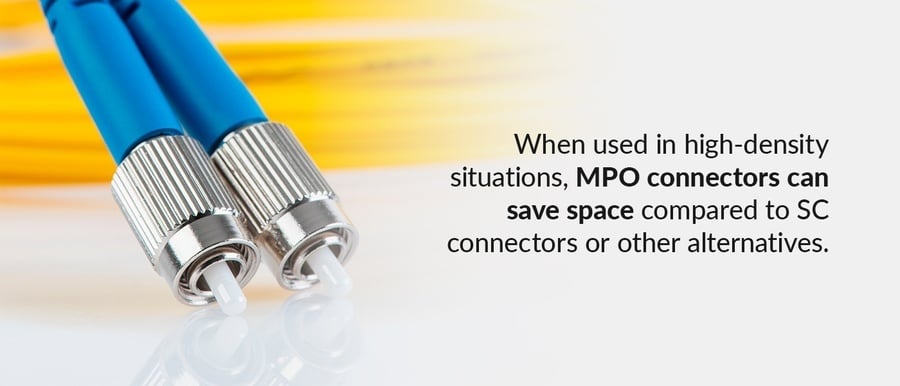
The main disadvantages of MT-RJ connectors are their rarity and their difficulty for field testing. Adding this type of termination to a fiber optic cable requires polishing and splicing, like the requirements for single-mode cables. Consequently, many technicians choose to use other multimode connectors for fiber optics that offer easier installation and testing.
When choosing among different fiber connectors, consulting a fiber optic connector types chart might help. Knowing the type of cable and the proper connectors for use with the cable and application help the most. The equipment the connector plugs into will also play a role in choosing the type to use. Ask the following questions about a project to choose the right fiber connector types:
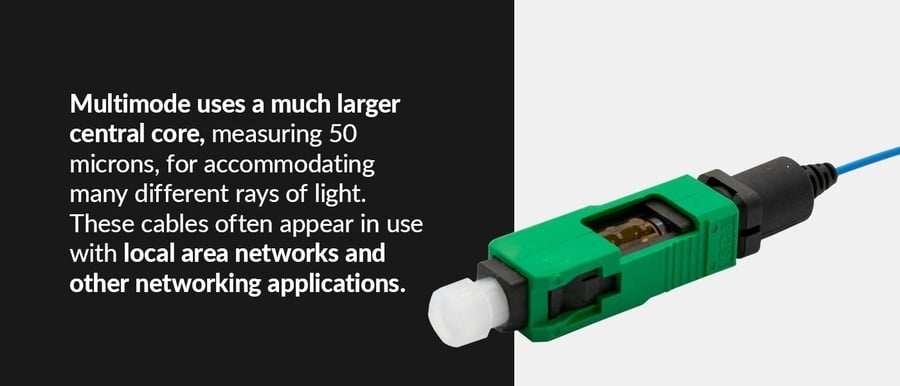
Cables have two main formats, single-mode and multimode. These modes describe the interior design and the number of rays that light travels through the fiber in. Single-mode fiber cable uses a 9-micron core through the center that light travels along in one path, thereby reducing loss and increasing potential bandwidth to 100,000 gigahertz. Both CATV and telephony use single-mode fiber cables.
Multimode uses a much larger central core, measuring 50 microns, for accommodating many different rays of light. These cables often appear in use with local area networks and other networking applications. The type of connector used must work with the cable design. For instance, SC connectors come in both single-mode and multimode formats.
To identify the type of cable, look at the jacket color. Single-mode cables have yellow or blue covers on the cables. Multimode fiber cables will be orange, bright green or aqua. Military applications also use plain green and slate for multimode cables. Since manufacturers differ in their color choices but remain consistent across the brand, always check with the cable maker first to verify the colors used.
Connectors also have colors to designate their type. Beige typically indicates multimode connectors. Blue is for ultra-physical contact (UPC) single-mode connections, and green goes with single-mode angled physical connector (APC) fiber connectors. When determining whether to use single-mode or multimode, another decision appears when choosing single-mode connectors — the type of physical contact.
The type of connection with single-mode cables is crucial. Today, single-mode connectors use physical contact (PC). Some PC connectors have convex ends, which increase the contact between the cores of the cables. This reduces loss and reflectance, earning the name of ultra-physical contact.
In some single-mode connectors, angling this physical connection to 8 degrees creates an angled physical connector, which reduces reflectance even more than convex PC connectors. This type of connection ensures better connectivity for use with CATV and similar applications.
Lastly, consider what type of connector the electronics require. Look at the type of connection required and use that to inform a decision on the type of terminations needed for the fiber optic cables leading to the device.
Find out more about custom fiber optic solutions for your business today. Multilink can help you sort through the different types of fiber connectors and their advantages and disadvantages. Our connectors work with any other products, regardless of brand. Plus, we provide customized bundles of fiber connectivity components for solutions that work with your needs.
For more than 35 years, we've created fiber optic packages for companies' various telecommunications needs. Our professional team can do the same for your business. Contact us at Multilink for more information about our fiber optic connectors, our telecommunications products and much more.
Back to Multilog